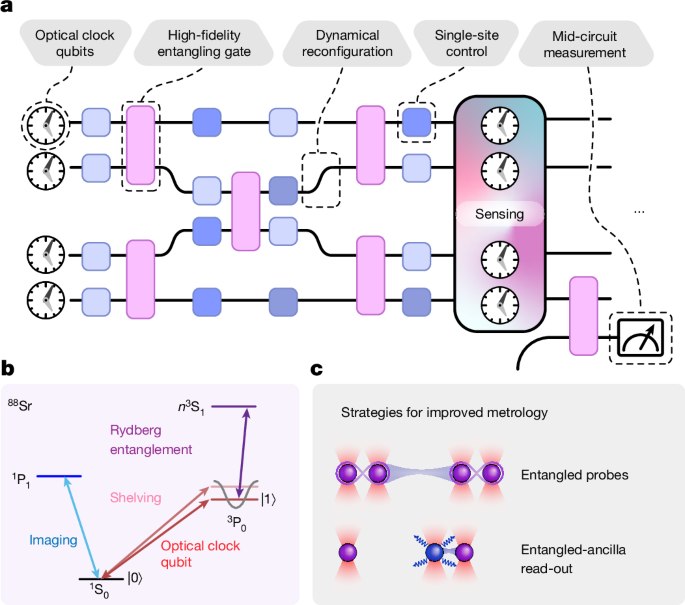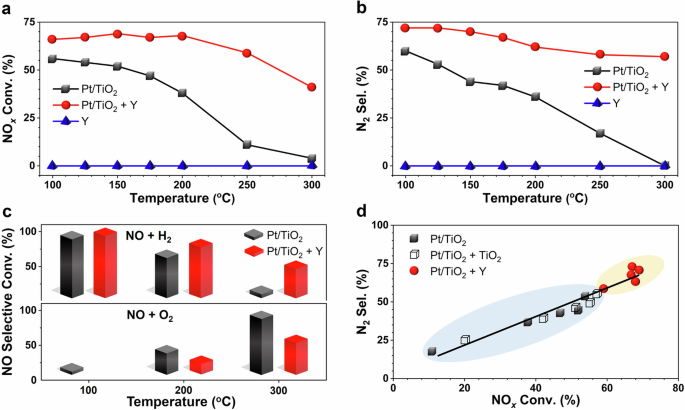2024-10-09 カリフォルニア工科大学(Caltech)
<関連情報>
- https://www.caltech.edu/about/news/merging-atomic-clocks-with-quantum-computers
- https://www.nature.com/articles/s41586-024-08005-8
- https://www.nature.com/articles/s41586-024-07913-z
ピンセットクロックのための普遍的量子演算とアンシラベースの読み出し Universal quantum operations and ancilla-based read-out for tweezer clocks
Ran Finkelstein,Richard Bing-Shiun Tsai,Xiangkai Sun,Pascal Scholl,Su Direkci,Tuvia Gefen,Joonhee Choi,Adam L. Shaw & Manuel Endres
Nature Published:09 October 2024
DOI:https://doi.org/10.1038/s41586-024-08005-8

Abstract
Enhancing the precision of measurements by harnessing entanglement is a long-sought goal in quantum metrology1,2. Yet attaining the best sensitivity allowed by quantum theory in the presence of noise is an outstanding challenge, requiring optimal probe-state generation and read-out strategies3,4,5,6,7. Neutral-atom optical clocks8, which are the leading systems for measuring time, have shown recent progress in terms of entanglement generation9,10,11 but at present lack the control capabilities for realizing such schemes. Here we show universal quantum operations and ancilla-based read-out for ultranarrow optical transitions of neutral atoms. Our demonstration in a tweezer clock platform9,12,13,14,15,16 enables a circuit-based approach to quantum metrology with neutral-atom optical clocks. To this end, we demonstrate two-qubit entangling gates with 99.62(3)% fidelity—averaged over symmetric input states—through Rydberg interactions15,17,18 and dynamical connectivity19 for optical clock qubits, which we combine with local addressing16 to implement universally programmable quantum circuits. Using this approach, we generate a near-optimal entangled probe state1,4, a cascade of Greenberger–Horne–Zeilinger states of different sizes, and perform a dual-quadrature5 Greenberger–Horne–Zeilinger read-out. We also show repeated fast phase detection with non-destructive conditional reset of clock qubits and minimal dead time between repetitions by implementing ancilla-based quantum logic spectroscopy20 for neutral atoms. Finally, we extend this to multi-qubit parity checks and measurement-based, heralded, Bell-state preparation21,22,23,24. Our work lays the foundation for hybrid processor–clock devices with neutral atoms and more generally points to a future of practical applications for quantum processors linked with quantum sensors25.
光クロックにおけるマルチ量子ゲートとシュレーディンガー猫の状態 Multi-qubit gates and Schrödinger cat states in an optical clock
Alec Cao,William J. Eckner,Theodor Lukin Yelin,Aaron W. Young,Sven Jandura,Lingfeng Yan,Kyungtae Kim,Guido Pupillo,Jun Ye,Nelson Darkwah Oppong & Adam M. Kaufman
Nature Published:09 October 2024
DOI:https://doi.org/10.1038/s41586-024-07913-z

Abstract
Many-particle entanglement is a key resource for achieving the fundamental precision limits of a quantum sensor1. Optical atomic clocks2, the current state of the art in frequency precision, are a rapidly emerging area of focus for entanglement-enhanced metrology3,4,5,6. Augmenting tweezer-based clocks featuring microscopic control and detection7,8,9,10 with the high-fidelity entangling gates developed for atom-array information processing11,12 offers a promising route towards making use of highly entangled quantum states for improved optical clocks. Here we develop and use a family of multi-qubit Rydberg gates to generate Schrödinger cat states of the Greenberger–Horne–Zeilinger (GHZ) type with up to nine optical clock qubits in a programmable atom array. In an atom-laser comparison at sufficiently short dark times, we demonstrate a fractional frequency instability below the standard quantum limit (SQL) using GHZ states of up to four qubits. However, because of their reduced dynamic range, GHZ states of a single size fail to improve the achievable clock precision at the optimal dark time compared with unentangled atoms13. Towards overcoming this hurdle, we simultaneously prepare a cascade of varying-size GHZ states to perform unambiguous phase estimation over an extended interval14,15,16,17. These results demonstrate key building blocks for approaching Heisenberg-limited scaling of optical atomic clock precision.



